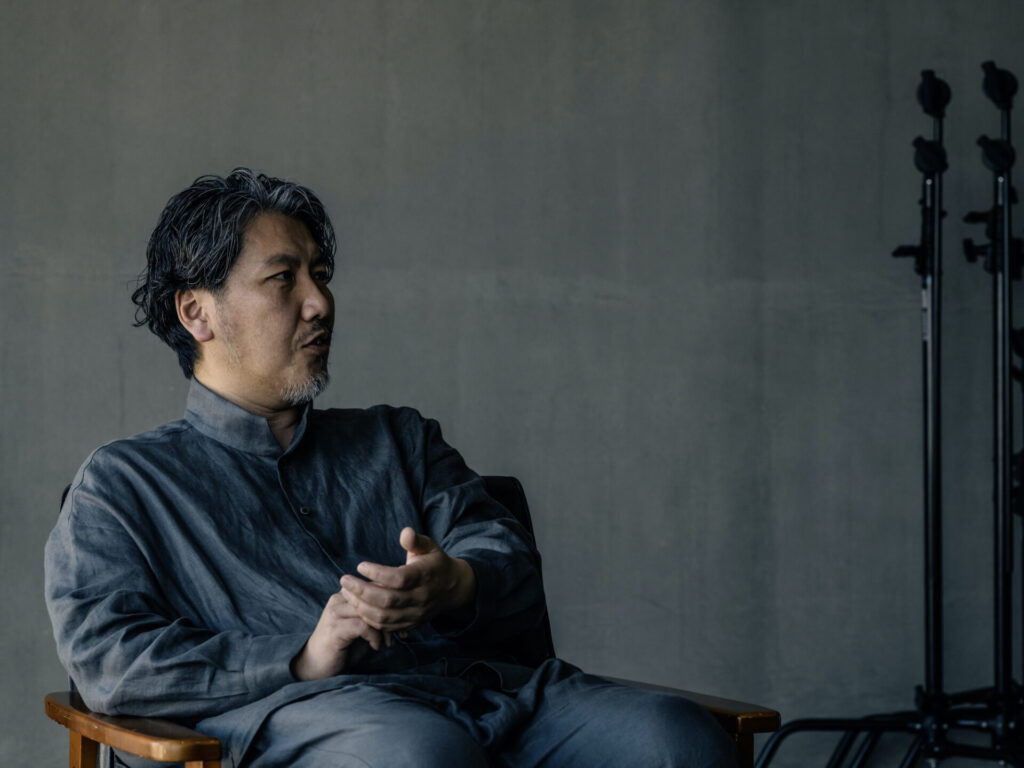
2024-05-18
Vol.6
Co-Founder / Representative Director at GiftX
Yuta Iitaka(part 1)
-
“Re-Selection” as New Alternative
-
From “Exchange” to “Co-Creation”
-
Sociality as Romance
Along with the changing times, the environment surrounding marketing is changing drastically. To further complicate the situation is the rise of digital marketing. With the widespread use of smartphones and advanced internet access, the penetration of SNS and video content has rapidly increased the points of contact with information. Nevertheless, Yuta Iitaka, today’s guest who has provided marketing support to many companies, thinks the essence of marketing is always the same. The original meaning of marketing is to create value and make it widely accepted in society. The two who share the same view discussed marketing for the next generation.

It is reasonable to re-select unnecessary gifts to reduce waste rather than dispose of them. (Shigeta)
Masakazu Shigeta: Today is the third time we have met.
Yuta Iitaka: Yes. At the beginning of this year, I made an offer to Mr. Shigeta for an interview in a marketing-related web media called “MarkeZine.” That was the first time we met.
Shigeta: Basically, I make it a rule to decline all interview offers from marketing and business-related media. I accepted Mr. Iitaka’s offer because I had read his book, “We Buy Things on SNS,” which made me understand the essence of SNS for the first time. I have a habit of sending a message to the author’s Facebook account whenever I am moved by reading their book, so I also sent a message at that time.
Iitaka: I checked the message history after you told me about it last time we met, and I certainly got it. I am sorry I did not notice it back then.
Shigeta: Having received the offer, I finally got the response after four years. (laughs)
This time, I offered him a dialogue interview because I thought Mr. Iitaka could discuss and think together about the essence of communicating things to others, not just things related to SNS.
——Mr. Iitaka, you launched a company called GiftX in 2022 and provide a service called “GIFTFULL,” where people can re-select the gift they received. Some people might think it is disrespectful for the sender to re-select the gift that they put a lot of thought into. How did you come up with the idea, and why did you decide to develop it into a business?
Iitaka: The ideal form of giving and receiving gifts is a “one-to-one” situation, where the receiver will surely like it and will not feel like changing it to another item. However, this is not always the case. I believe everyone has the experience that a gift received for a wedding or baby shower was the same one they have already received from someone else. Our service shows that 46% of receivers decide to change and re-select the gifts. The gifts sometimes miss the mark, let’s say, about two times out of ten. A survey shows that the size of the gift market in Japan is about ten trillion Japanese yen in annual sales. If half of the off-target gifts are disposed of, it is a huge loss to society. To improve such situations, I thought we could have a choice to “re-select” the gift as an alternative, which would be better for both the sender and receiver. That is why I started the service GIFTFUL.

——In addition to reducing the gifts that are unused or thrown away, you said you also hope re-selection encourages new communication.
Iitaka: Exactly. Let me tell you a story about a sender who chose alcohol for the gift. The receiver always liked alcohol, so it should be the best gift, but the problem is the receiver happened to take a break from alcohol at the time. The receiver eventually changed the gift to a sauna towel and sent an online gratitude message explaining the situation. What happened afterward was that the interaction made them agree to go to a sauna together the next time. The conventional gift-giving ends with a “thank you” after receiving it, but this example shows a new conversation created through the gift-giving brought them to the next step. We put the most value on such interactions, and re-selection is one of the means to create it.
——Mr. Shigeta, you must have a lot of opportunities to send gifts, and we are sure you must always pay extra attention to the selection. From your standpoint, how did you feel about Mr. Iitaka’s idea?
Shigeta: For me, people in Mr. Iitaka’s generation are the ones I am least comfortable with. (laughs) I think they have the opposite ways of thinking from my generation. The ideas on “rationality” probably differ a lot as well.
I would never come up with something like the re-selection of the gifts.
Whenever I send gifts, I do detailed research on their background and preferences to choose something the receiver doesn’t have. In my opinion, the best gifts are something the receiver doesn’t buy themself but has always wanted. Since I thoroughly consider what kind of gifts would meet the requirements, I will be very annoyed if I hear that my gift has been re-selected. (laughs)
Having said that, from the perspective of social issues, it is reasonable and understandable that the re-selection of the gifts is better than their disposal. But the act itself is not romantic for me. I understand it, but I don’t take such actions; that is our decisive difference on this topic.

Marketing is recognizing the brand story as well as the impression and experience that comes from the products as the value and spreading it to society. (Iitaka)
——I would also like to ask you about marketing. The term “marketing” has a wide range of interpretations from person to person. Recently, we have had digital marketing, SNS marketing, and in the future, we might have something like generative AI marketing. There is a tendency for “marketing” to be classified into various categories. In such circumstances, what are your thoughts on the essence of marketing?
Iitaka: Actually, I distrust the situations where people add anything and everything in front of the word “marketing.” Speaking of the definition, in 1990, the Japan Marketing Association defined it as “Exchange,” and it has been widely accepted in Japan. It is like, “I like this product, so I pay for it.” But it was revised this January for the first time in 34 years and changed to “Co-Creation.” In short, marketing is not only about the monetary value of the products but also about the story of the brands, the impression and experience that comes from the products, and the process of spreading the value to society as a whole.
One of the most common mistakes people make is that they think marketing is a method. While people believe the customer perspective is essential, they immediately begin to quantify everything once they start thinking about the approach; they only focus on the advertisement strategy and budget for a single customer to buy the products. We can find a similar approach in the subscription system: some companies prefer it because it is easier to grasp sales figures. Most of these are corporate-first approaches, and there is no customer perspective. Of course, customers prefer the subscription style in some cases.
Shigeta: Marketing is often explained in the 4Ps: Product, Price, Promotion, and Place. However, the dot-com bubble and its collapse around 2000 significantly impacted the idea of marketing. During Japan’s high economic growth period and bubble economy, the standard payback period was 10 to 15 years, but the dot-com bubble crash dramatically shortened the period. The reason is that the speed of the dot-com crash was so rapid that investors started to think they were losing vast amounts of money with the conventional payback period and, as a result, shortened it to 3 to 5 years. The same thing happened in venture investment. They started to invest in a company on the condition that it would go public within three years, and once they got the capital gain, they left. Such movement made marketing fall into the trap of method. People started to think that, rather than taking time to improve the products, it is better to leave the product as it is and recover the capital through advertising and marketing. The Product and Place of the 4Ps were ignored, and marketing has become all about Price and Promotion. I believe that is the major change in marketing in the past 20 years.
——The renewal of the definition from “Exchange” to “Co-Creation” might reflect the desire to change such trends.
Shigeta: One of the investors for our brand, Osaji, is the Next Generation Business Development Division of Marubeni. They set the payback period as 10 to 15 years because long-term investment brings them a bigger return in the long run. They know from experience that short-term investment of 3-5 years has low margins. So, they set 2030 to 2040 as the target in the payback schedule for the investment in our company, which enabled us to preferentially devote the resources to what is necessary for the next generation, such as the review of products.
We are lucky to have this partnership with Marubeni because it allows us to rethink our products. Also, it has made us realize that this is the only way to create companies with
authenticity or brands that last 100 years.
No matter how much short-term marketing you do, products will only sell when demanded by society. If forced to buy, customers will have a bad impression of the brand and manufacturer. There are many stories that customers are disappointed with products that are advertised as if they are great but actually useless. In that sense, we have to re-examine the meaning of marketing properly.
The story of Mr. Takeshi Otaka, who appeared in the vol.1 of Idealism, was a perfect example of “Co-Creation.” His business creates a system where people pay, not for the products, but for the society someone is trying to build, the future someone is trying to bring about, and the virtue someone is trying to express. People pay for such attitudes and receive products or services in return. In a sense, I believe general consumption behavior is also changing in a direction similar to crowdfunding.
Note:
The 4Ps of Marketing
A framework proposed by Edmund Jerome McCarthy in the 1960s.
The “4Ps” refer to Product, Price, Promotion, and Place. Originally, the framework had the “C” of the Customer at the center of the 4Ps, but as the framework spread, the “C” disappeared, making the customer absent.

What is important is something “that doesn’t make money.” It is the background and story behind the products. (Shigeta)
Shigeta: I think we live in an era where two paradigms run side by side. One group understands the background and context of things, while the other group merely consumes things without a slight understanding of them. The problem is that there is no “gradation” between the two groups. Those who understand it have a perfect understanding, while those who do not have no understanding: there is a huge gap between the two. I’m concerned about the lack of gradation between the two groups because, without gradation, it would take a much longer time for society to move in a better direction. So, I hope some of them will listen to my idea through this media Idealism.
Iitaka: I agree with you on the problem of “gradation.” People often use SWOT matrix, which combines Strengths, Weaknesses, Opportunities, and Threats in a matrix for comprehensive analysis, but the problem is it is all flat. I always feel something is wrong with it because there should always be a depth, like the gradation you mentioned.
Since frameworks have become available anywhere, when people turn from the consumer to the seller side, they rely too much on charts and figures. They forget how they used to purchase products. Instead, they only focus on numbers, like how many sales they will get when they put a product on a particular shelf of a specific drugstore, and they scramble to get the space on the shelf. However, consumers don’t care about the position of the product on the shelf when they purchase it.
For example, when your friends say OSAJI is excellent, and you go to the actual store for a trial, and if you like it, you buy it online. Here, the e-commerce platform directly contributes to sales, but in reality, word-of-mouth and in-store trials contribute far more to the behavior. As the spread of the Internet and the advent of smartphones have allowed people to get information quickly, behaviors before purchase have much more important meanings.
——Mr. Iitaka, you once mentioned that people now obtain information on good products and services in daily communication, like water-cooler conversation, similar to the old days.
Iitaka: That is exactly what I mean. When you are interested in the products your friends use, you will ask how they feel about it, right? The point is that the information you get from your friend is “hidden information.” If you purchase the product later, it means the communication between the two has contributed to the purchase. This sort of interaction between individuals is called “dark social,” and the contents and the history of the conversation are not visualized as data. Although such information is difficult to measure for companies and brands, that is where the value lies.
Shigeta: Today, I brought members of an experimental team in our company. This team has members of various generations, including newcomers who joined this spring. I have asked them to work on a project together. The purpose of forming a team is that firstly, I want to learn things by working with them, and more importantly, I want young members to obtain thinking skills, avoiding a simple way of regarding KPI as the awareness rate.
Certainly, the awareness rate in marketing is essential because increasing the rate brings about purchase behavior. However, I believe that the “awareness rate x quality of awareness” is the most critical factor. Being recognized is necessary, but it becomes meaningful only when multiplied by the quality of how it is recognized. And what is the coefficient of quality in that sense? It is NPS (Net Promoter Score). In Japan, few people emphasize NPS, but the figure is important in the U.S. For example, even if a company is in a bad financial condition, banks will lend money as long as the NPS is high. It’s natural, isn’t it? If you have products and brands that are recommendable to others, all you need to do is focus on marketing. The banks judge they can safely collect money.
So, what is the way to increase NPS? I don’t deny the idea of raising sales by direct conversion and investing in marketing for that purpose, but I don’t think people with such a way of thinking can answer the question of how to increase NPS. I believe the actions necessary to improve NPS is to do something “that doesn’t make money.” It is not the value that can be easily converted into money, such as user-friendly or cool design, but the background and story behind the products that matter.

Iitaka: When we recommend products, the reason is not limited to their functionality.
Shigeta: Yes. Let me tell you a story about a restaurant I sometimes visit. The restaurant serves extraordinarily delicious cuisine, but the staff members there have terrible service attitudes. The food and wine are good, so they have beliefs in what they serve. So, I go there with the understanding that there is no risk if we do not communicate with the staff. However, I do not recommend it to people around me. I am reluctant to do it because I want to avoid receiving feedback that they had unpleasant experiences at the place I recommend. In that sense, I have a low NPS for the restaurant.
The restaurants might believe the essence of their service is to provide good food, but it is the background and service that make the customers feel trust and attachment to the restaurants. This is an excellent example of why background and story are essential.
Iitaka: The story you just shared has something to do with why people continue to have actual stores while the ratio of E-commerce has been increasing. Actually, many customers want to buy items from a particular store staff member. At a company I consult with, store clerks change the way they communicate with customers by customers. Checking the customer’s outfits, they occasionally recommend another brand without hesitation if they think it suits the customer better. Ultimately, some of them do not try to sell their clothes. However, as a result, it leads to trust and continuous purchases. That sort of service and attitude is priceless.
Shigeta: Speaking of background, “sociality” has recently become closely related to the brand story, and I would say 60 to 70% of them are related to sociality. Being eco-friendly is one of them, but it is already old-fashioned because it has become a natural duty for manufacturers. So what is sociality now? I believe it is romance. For example, if you want to create a fully diverse society, developing products necessary for such a society is natural. Unlimited to producing and selling, trying to enrich society and culture with ideals and thoughts is also natural. I have taken it for granted, but when asked if it would be tomorrow’s sales, I can only say “No.” So, I always think about what excuses will convince people around me. But, after all, all I do is act toward the future that I feel is romantic. It all comes down to producing and providing products necessary for a romantic society. It is simple.
Iitaka: Focusing on what you want to be and putting your dream and energy as much as possible into it. Ultimately, that is the most important, after all.

Note:
KPI
KPI stands for Key Performance Indicator, which quantitatively evaluates the degree of achievement of the goal. Setting KPIs correctly will bring about positive effects such as “visualization of goals” and “clarification of the necessary actions,” which make companies precisely understand progress toward the goal.
(to be continued in the second half)
Profile
-
Yuta Iitaka
Iitaka was born in 1986 in Tokyo. After serving as an executive officer at Basic Inc. and CMO at Hotto Link Inc., Iitaka co-founded GiftX in June 2022 with the theme “Evolution along with Warmth of People.” As a representative director, he manages GIFTFUL, a social gift service that allows receivers to re-select the gifts. The company was selected in the “Commerce” field of Nikkei Cross Trend’s 2024 edition of “100 Companies to Create Future Markets.” In addition to running GiftX, he is also active as a corporate marketing advisor. He has consulted for more than 150 companies so far.
Publications
Bokura wa SNS de Mono wo Kau (We Buy Things on SNS) (Discover 21, 2019)
SNS Marketing 7 tsu no Tessoku (7 Golden Rules of SNS Marketing) (Nikkei BP, 2023)
BtoB Marketing no Kiso Chishiki (Basic Knowledge of BtoB Marketing) (Mynavi Publishing, 2022)
Athlete no tame no Social Media Katuyou Jutsu (Social Media for Athletes) (Mynavi Publishing, 2019) -
Masakazu Shigeta
After working as an engineer in the music industry, Shigeta began his career as a cosmetics developer in 2001. Since 2004, he has produced a variety of cosmetics brands in the healthcare business of Nitto Denka Kogyo Co., Ltd., a metal surface treatment company founded by his great-grandfather.
In 2017, he founded Osaji, a skincare lifestyle brand, and became the brand director. He also produced Kako, a specialized shop for home fragrances perfume in Kuramae, Tokyo, in 2021, and a combined shop of Osaji, kako, and a restaurant enso in Kamakura, Kanagawa, in 2022.
In 2023, using Nitto Denka Kogyo’s skills, he produced a pottery brand, HEGE, and he also opened a restaurant serving rice porridge, HENGEN, in Kita-Ueno, Tokyo.
Publications
Taberu Biyou (Eating for Beauty) (SHUFU TO SEIKATSU SHA, 2024)
42-Sai ni Nattara Yameru Biyou, Hajimeru Biyou (Beauty cares to quit and start when you turn 42) (Takarajimasha, 2022)
Information
GIFTFUL
GIFTFUL is a new style of social gift service where senders select a gift, and receivers have the option to accept the gift or re-select it for another item of the same or lower value. The service allows the sender to add the considerate option of “re-selection” to the thoughtful gift.
https://giftful.jp/
GIFTFUL Corporate Plan
The corporate plan of GIFTFUL offers re-selectable corporate gifts, which enhance customer and employee experience. The re-selectable option delights the recipient. The payment is only necessary when the gift is accepted.
https://giftful.jp/business
Giftx Marketing Support
Experienced marketing professionals provide practical support and solutions to the sluggish business growth faced by companies in BtoB service, media, and e-commerce.
https://giftx.co.jp/marketing-support
-
Photographs:Eisuke Komatsubara
-
Text:Masahiro Kamijo